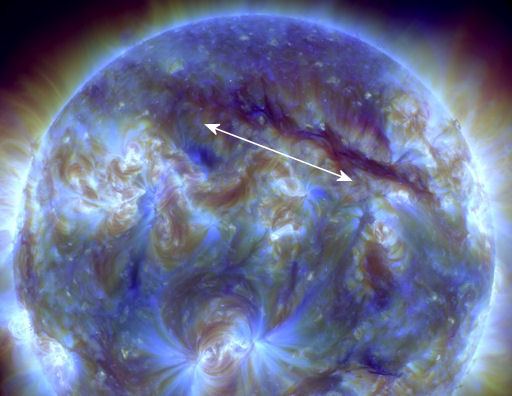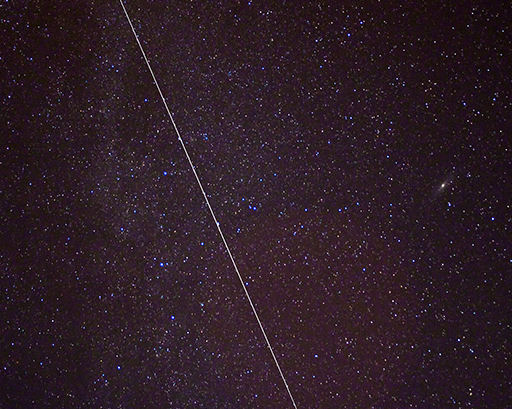LEONID METEOR SHOWER: Earth is passing through the debris field of Comet Tempel-Tuttle, parent of the annual Leonid meteor shower. Barring a direct hit by a filament of dust, which forecasters consider unlikely, this year's shower should be mild. Peak rates of 10 to 20 meteors per hour are expected on Nov. 17th and 18th. [live counts] [meteor radar]
GREAT FILAMENT: It's one of the biggest things in the entire solar system. A dark filament of magnetism measuring more than 800,000 km from end to end is sprawled diagonally across the face of the sun. NASA's Solar Dynamics Observatory took an ultraviolet picture of the structure during the late hours of Nov. 17th:
If the filament becomes unstable, as solar filaments are prone to do, it could collapse and hit the stellar surface below, triggering a Hyder flare. Indeed, part of the filament already erupted on Nov. 16th, but Earth was not in the line of fire when the twisted lines of magnetism snapped. A similar event today would likely be geoeffective because of the filament's central location on the solar disk. Solar flare alerts: text, phone
SHENZHOU 8 RETURNS TO EARTH: China's unmanned Shenzhou 8 probe returned to Earth on Nov. 17th, wrapping up a three-week mission to the Tiangong 1 space station. Shenzhou 8 spent its time in orbit practicing rendevous and docking maneuvers with China's new space station. Chinese authorities say the mission was a complete success.
China's growing presence in Earth orbit may be seen with the unaided eye. On Nov. 14th, David Blanchard watched the Tiangong 1 glide past the Andromeda galaxy in the crystal-clear skies of Flagstaff, Arizona:
"The space station zipped brightly across the sky, then swiftly faded away as it entered Earth's shadow," says Blanchard. "It was easy to see."
The "Heaveny Palace" (Tiangong in English) will be making a series of bright flybys of North America in the nights ahead. Check the Satellite Tracker or your smartphone for local flyby times.

Solar wind
speed: 378.3 km/sec
density: 0.5 protons/cm3
explanation | more data
Updated: Today at 0036 UT
X-ray Solar Flares
6-hr max: C3 1929 UT Nov17
24-hr: C6 0727 UT Nov17
explanation | more data
Updated: Today at: 2359 UT
![]()
Daily Sun: 17 Nov 11
Sunspot 1346 poses a slight threat for Earth-directed M-flares. Credit: SDO/HM
FLARE | 0-24 hr | 24-48 hr |
CLASS M | 20 % | 20 % |
CLASS X | 01 % | 01 % |
![]()
Geomagnetic Storms:
Probabilities for significant disturbances in Earth's magnetic field are given for three activity levels: active, minor storm, severe storm
Updated at: 2011 Nov 17 2200 UTC
Mid-latitudes
0-24 hr | 24-48 hr | |
ACTIVE | 10 % | 10 % |
MINOR | 02 % | 02 % |
SEVERE | 01 % | 01 % |
High latitudes
0-24 hr | 24-48 hr | |
ACTIVE | 17 % | 17 % |
MINOR | 22 % | 22 % |
SEVERE | 13 % | 13 % |




